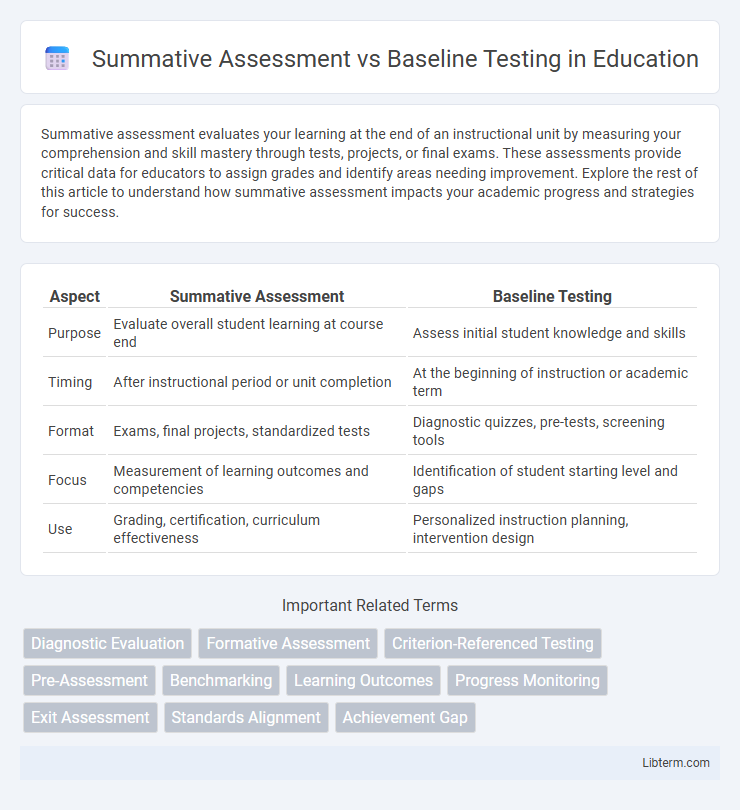Summative assessment evaluates your learning at the end of an instructional unit by measuring your comprehension and skill mastery through tests, projects, or final exams. These assessments provide critical data for educators to assign grades and identify areas needing improvement. Explore the rest of this article to understand how summative assessment impacts your academic progress and strategies for success.
Table of Comparison
| Aspect | Summative Assessment | Baseline Testing |
|---|---|---|
| Purpose | Evaluate overall student learning at course end | Assess initial student knowledge and skills |
| Timing | After instructional period or unit completion | At the beginning of instruction or academic term |
| Format | Exams, final projects, standardized tests | Diagnostic quizzes, pre-tests, screening tools |
| Focus | Measurement of learning outcomes and competencies | Identification of student starting level and gaps |
| Use | Grading, certification, curriculum effectiveness | Personalized instruction planning, intervention design |
Understanding Summative Assessment
Summative assessment evaluates student learning at the end of an instructional period, providing a comprehensive measure of knowledge acquisition and skill mastery. It typically includes final exams, standardized tests, or end-of-unit projects that quantify overall academic achievement. Understanding summative assessment is crucial for educators to gauge curriculum effectiveness and inform future instructional strategies.
Defining Baseline Testing
Baseline testing establishes a student's initial knowledge, skills, and abilities before instruction begins, setting a reference point for measuring progress. It captures performance data that informs tailored teaching strategies and identifies learning gaps early in the educational process. Unlike summative assessment, which evaluates overall achievement at the end of a unit, baseline testing provides a foundational benchmark to guide personalized learning interventions.
Key Objectives of Summative Assessment
Summative assessment aims to evaluate student learning by measuring knowledge retention and academic achievement at the end of an instructional period. It provides comprehensive data on student performance through standardized tests, final exams, or project evaluations, enabling educators to determine if learning objectives and curriculum standards have been met. The key objectives include assessing competency, informing grade assignments, and guiding future instructional planning based on overall student outcomes.
Primary Purposes of Baseline Testing
Baseline testing primarily serves to establish students' initial knowledge and skills before instruction begins, providing a clear starting point for measuring progress. It enables educators to identify learning gaps and tailor teaching strategies to meet individual needs effectively. By comparing baseline data with future assessments, educators can gauge the effectiveness of instructional methods and adjust them to improve student outcomes.
Differences in Timing and Implementation
Summative assessment occurs at the end of an instructional period to evaluate student learning and mastery, while baseline testing takes place at the beginning to establish initial skill levels and knowledge. Summative assessments typically use standardized tests or final projects, providing evaluative data for grading and curriculum effectiveness. Baseline testing guides instructional planning by identifying strengths and gaps, allowing educators to tailor teaching strategies from the outset.
Data Generated: Summative vs Baseline
Summative assessment generates data reflecting overall student performance and learning outcomes at the end of an instructional period, providing cumulative evidence of mastery and effectiveness of teaching methods. Baseline testing collects initial data on student knowledge and skills before instruction begins, establishing a point of comparison to measure growth and progress. While summative data informs educators about achievement levels, baseline data is critical for tailoring instruction and setting realistic learning targets.
Impact on Instructional Planning
Summative assessment provides educators with comprehensive data on student learning outcomes at the end of an instructional period, helping to evaluate the effectiveness of teaching strategies and curriculum alignment. Baseline testing identifies students' existing knowledge and skills before instruction begins, enabling teachers to tailor lesson plans to meet diverse learner needs and set targeted learning goals. Together, these assessments inform instructional planning by guiding adjustments in teaching methods and resource allocation to optimize student achievement.
Strengths and Limitations of Each Method
Summative assessment provides a comprehensive evaluation of student learning outcomes at the end of an instructional period, enabling educators to measure achievement against predetermined standards, yet it may not offer insights into ongoing progress or individual learning gaps. Baseline testing establishes initial student knowledge and skills, guiding tailored instruction and goal-setting, but its effectiveness is limited by potential test anxiety and variability in student preparedness. Both methods are essential; summative assessments excel in accountability and curriculum evaluation, while baseline tests optimize personalized learning pathways despite their constraints.
Choosing the Right Assessment Strategy
Summative assessment evaluates overall student learning at the end of an instructional period, providing quantitative data on achievement and mastery of specific standards, ideal for measuring outcomes and accountability. Baseline testing establishes students' prior knowledge and skill levels before instruction begins, guiding differentiated teaching strategies and setting realistic learning goals. Choosing the right assessment strategy depends on instructional objectives, timing within the learning cycle, and the need for either diagnostic insights or final performance measurement.
Integrating Summative Assessments and Baseline Testing
Integrating summative assessments and baseline testing enhances educational insight by combining initial student performance data with final outcome evaluations. Baseline testing establishes a reference point for student abilities at the start of a course, enabling targeted instruction, while summative assessments measure cumulative learning at the end, validating instructional effectiveness. Utilizing both methods in tandem supports data-driven decision-making, improving curriculum design and personalized learning strategies.
Summative Assessment Infographic

 libterm.com
libterm.com